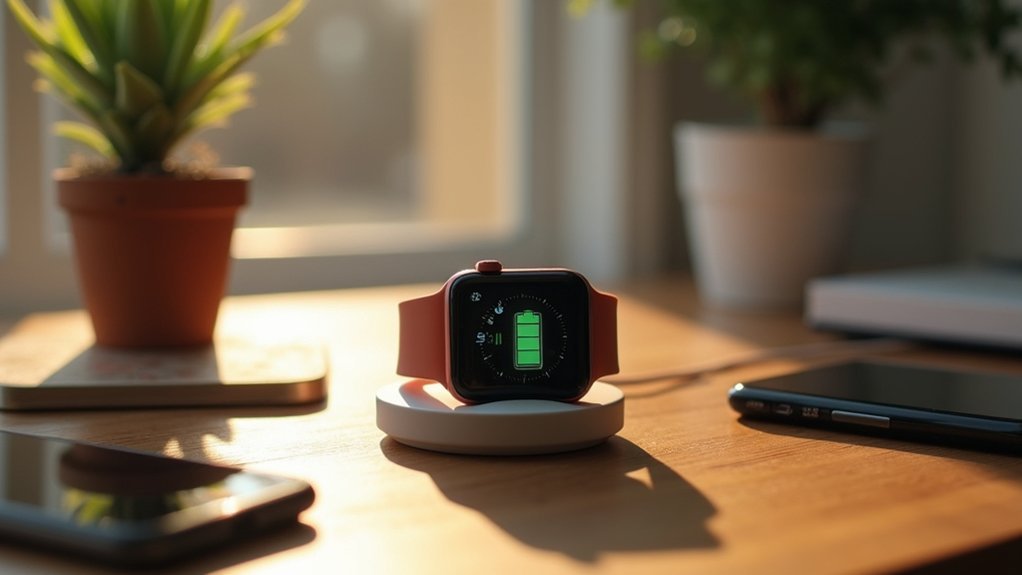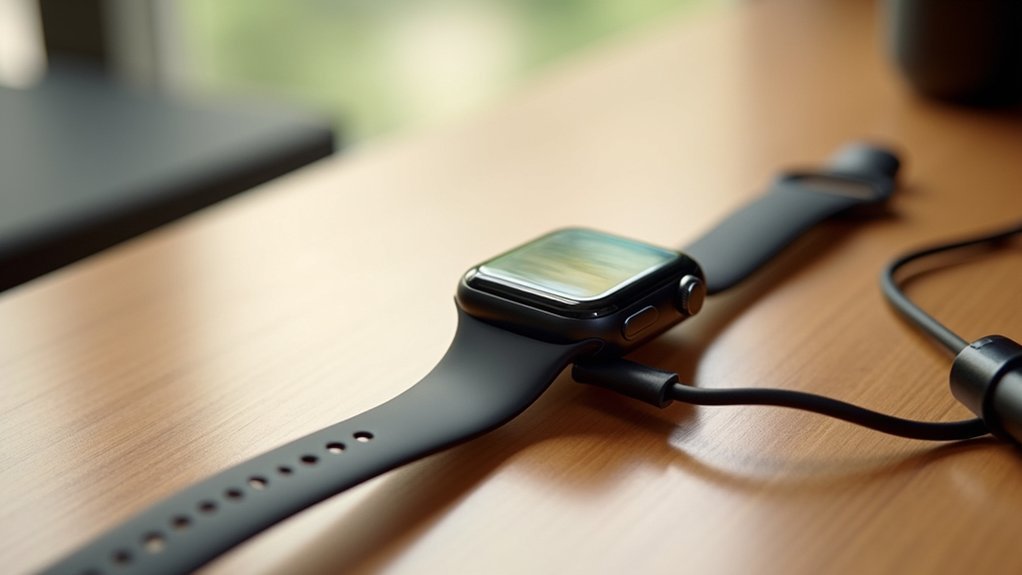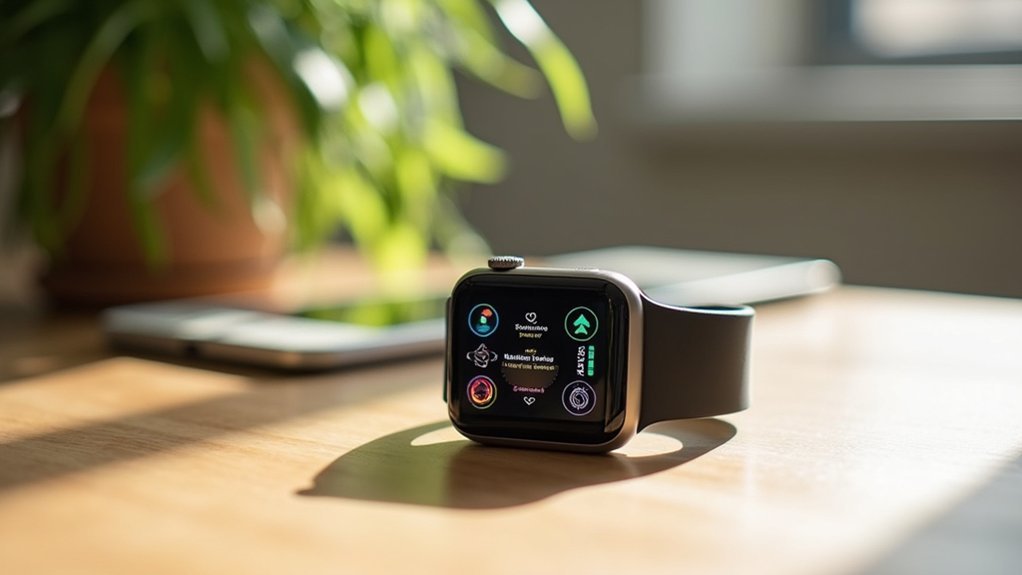To maximize your Apple Watch battery life, disable the always-on display, use Low Power Mode when needed, turn off background app refresh for non-essential apps, limit notifications to important alerts only, enable Optimized Battery Charging, reduce screen brightness, and disable cellular connectivity when near your iPhone. Managing these power-hungry features can extend your watch’s runtime by several hours each day. These simple adjustments will keep your watch functioning longer between charges without sacrificing its most valuable features.
7 Effective Apple Watch Battery Optimization Techniques

While Apple Watches offer impressive functionality, their battery life remains a common frustration for many users.
Fortunately, several effective optimization techniques can greatly extend your watch’s daily endurance.
Start by disabling the always-on display through Settings > Display & Brightness > Always On. This single change dramatically reduces power consumption.
Next, turn off background app refresh to prevent unnecessary battery drain from apps updating when you’re not using them.
If you have a cellular model, disable cellular connectivity when near your iPhone or in Wi-Fi areas.
Lower your screen brightness and reduce wake duration in settings.
Finally, consider limiting continuous heart rate monitoring and other sensor activities when they’re not essential.
These targeted adjustments address the main power-consuming functions, helping your Apple Watch last longer between charges. Activating Power Saving Mode during workouts can significantly extend battery life while still tracking your essential fitness metrics.
Master the Power of Low Power Mode
Among all battery-saving features, Low Power Mode stands as the most powerful tool in your Apple Watch arsenal. Activate it by tapping the battery percentage in Control Center and toggling it on. You’ll notice a yellow icon at the top of your screen confirming it’s engaged.
When enabled, Low Power Mode disables power-hungry features like the Always On display, background heart rate monitoring, and blood oxygen measurements. It also limits Wi-Fi and cellular connections to essential usage only. For outdoor workouts, this mode significantly extends battery life by reducing GPS readings and limiting heart rate measurements.
Your watch automatically suggests Low Power Mode when battery reaches 10%, but you can proactively set it for 1-3 days during trips.
The mode automatically deactivates once your battery charges to 80%, or you can manually turn it off through Control Center when you need full functionality again.
Customize Your Always-On Display Settings

The Always-On display feature, while convenient, considerably impacts your Apple Watch battery life if not properly customized.
You can fine-tune this feature by adjusting which complications remain visible and suppressing notifications when your watch is inactive.
Your watch will automatically dim during periods of inactivity, but manually configuring these settings creates the ideal balance between information accessibility and power conservation. For maximum battery conservation, you can completely turn off the Always-On feature through the Display & Brightness section in the Settings app.
Balance Visibility Versus Battery
Finding the right balance between display visibility and battery conservation represents one of the most critical aspects of Apple Watch power management.
You’ll achieve this balance through strategic customization of your Always-On Display (AOD) settings. Start by selecting minimalist watch faces with darker backgrounds, which consume less power on OLED screens.
Then customize which complications remain visible during AOD mode—hiding non-essential ones reduces elements that frequently refresh. Similarly, consider hiding notifications in AOD mode when you don’t need constant visibility.
Adjust your display brightness to lower levels while maintaining readability, and experiment with text boldness settings for further optimization. Note that the Always On feature is unavailable on Apple Watch SE models, so these specific settings won’t apply to that version.
Remember that these adjustments work together; combining reduced brightness with simplified complications and darker watch faces yields the best battery efficiency without sacrificing essential functionality.
Dim During Inactivity
Customizing how your Apple Watch dims during periods of inactivity offers considerable battery savings while maintaining essential functionality.
For Series 5, SE (2nd gen), Ultra, and later models, navigate to Settings > Display & Brightness > Always On to control this feature.
Toggle off “Show Complications” to remove secondary data from your idle display, considerably reducing power consumption. Similarly, disabling “Show Notifications” prevents unnecessary screen activations. To access these options, tap on the Always On option within the Display settings after scrolling down in the Settings app.
Your watch automatically switches to grayscale when inactive, but you can enhance this battery-saving behavior through these settings.
Remember that your Always-On display still responds intelligently to your movements – deactivating when off-wrist and dimming when your wrist is down.
For activities requiring maximum battery life, consider temporarily disabling Always-On entirely, especially when constant visibility isn’t necessary.
Manage Background App Refresh Strategically
Background App Update lets your Apple Watch update content even when you’re not actively using certain apps.
However, this continuous activity can drain your battery faster.
You’ll find significant power savings by identifying which apps truly need background updating and disabling this feature for non-essential applications.
Take control of your watch’s battery life by heading to Settings > General > Background App Update and toggling off permissions for apps that don’t require constant updates. While you customize these settings, be aware that complications on watchfaces will continue to refresh regardless of your background app refresh selections.
Understanding App Drain
While many Apple Watch users enjoy the convenience of real-time updates, few realize how considerably Background App Refresh impacts battery life. This feature, enabled by default, allows apps to check for new content even when you’re not using them.
You’ll notice this drain especially with frequently updating apps like news or social media. To identify your biggest battery drainers, monitor which apps update most often or send numerous notifications. Quitting apps from the app switcher may actually prevent background updates and help extend your battery life.
Consider your priorities when managing this feature. You can turn off Background App Refresh entirely through Settings > General > Background App Refresh, or disable it selectively for specific apps.
Remember that apps with complications may still update regardless of this setting. Though disabling refresh might delay some updates, the significant battery savings are often worth this minor trade-off.
Selective App Permissions
Taking strategic control of which apps can work behind the scenes is arguably the most effective battery optimization technique for your Apple Watch.
Background App Refresh allows apps to update even when you’re not using them, but this convenience comes at a battery cost.
To manage these permissions, access Settings > General > Background App Refresh on your iPhone’s Watch app. Selectively enable this feature only for essential apps while disabling it for others.
When Low Power Mode is active, this feature automatically turns off to conserve battery.
If you find Background App Refresh options grayed out, check your Screen Time restrictions. Navigate to Settings – Screen Time – Content & Privacy Restrictions to ensure Background App Activities are allowed.
Remember that location-based apps may function differently with this feature disabled, so balance functionality with battery life when making your selections.
Optimize Notification Delivery for Battery Savings

Notifications play a critical role in Apple Watch battery consumption, as each alert activates the display and drains power. Minimize this impact by curating which apps can send alerts to your watch.
Use the Watch app on your iPhone to disable notifications for non-essential applications, especially social media and messaging platforms.
Take advantage of the granular control options by setting less important alerts to “Deliver Quietly.” Disable time-sensitive notifications that bypass Focus modes when possible.
Strategically schedule Focus periods to batch notifications rather than receiving constant interruptions.
Be mindful of notification backlogs when powering your watch on after extended downtime. Enable earlier battery alerts to proactively manage power levels before reaching critical thresholds. Consider setting up alerts at 30%, 20%, and 10% to avoid unexpected battery depletion during your workday.
These simple adjustments will markedly extend your watch’s daily runtime.
Leverage Optimized Battery Charging Feature
To maximize your Apple Watch’s battery longevity, Apple’s Optimized Battery Charging feature serves as a powerful ally in reducing battery wear.
This intelligent function charges your device to 80% initially, then completes the final 20% shortly before you typically use your watch. The system uses on-device machine learning to predict when you’ll need your watch fully charged.
Available on watchOS 7 and later, this feature learns your daily habits and adapts accordingly.
When you charge overnight, it’ll pause at 80% and finish charging just before you wake up, reducing the time your battery spends at full capacity.
You can easily toggle this setting on or off in your Apple Watch settings, or manually override it when you need a full charge immediately.
Control Cellular and Connectivity Options

Your Apple Watch’s cellular and wireless connections, while essential for functionality, can quickly deplete battery reserves if left unchecked.
Disable cellular connectivity when not needed, especially in areas with poor reception where your watch expends more energy searching for signals.
Take advantage of airplane mode, which turns off all connectivity features at once—ideal for meetings, movies, or when battery conservation is critical.
For workouts, enable the Power Saving Mode to maintain essential tracking while limiting battery-hungry features. When traveling, manually toggle Wi-Fi instead of using Airplane mode to avoid unnecessary extra steps when managing your connectivity.
Don’t forget to manage location services judiciously; GPS tracking is particularly power-intensive.
Turn it on only when necessary for navigation or fitness tracking. Regularly review which apps have access to your location and restrict those that don’t need it.
Frequently Asked Questions
Can I Replace My Apple Watch Battery Myself?
Yes, you can replace your Apple Watch battery yourself with the right tools and careful attention to detail. You’ll need heat tools, precision screwdrivers, and a replacement battery kit for your specific model.
How Does Temperature Affect Apple Watch Battery Performance?
Temperature greatly impacts your Apple Watch’s battery. Cold reduces battery life, while heat above 95°F can permanently damage capacity. Your watch may dim displays or slow functions when hot, and perform poorly in freezing conditions.
Will Using Third-Party Charging Accessories Damage My Battery?
Third-party chargers with MFi certification won’t damage your battery. However, non-certified options can cause overheating, incorrect voltage delivery, and reduced battery lifespan. Always choose reputable brands with the Made for Apple Watch badge.
How Accurate Is the Battery Percentage Display?
Your Apple Watch’s battery percentage is generally reliable but not perfect. It may occasionally show inaccuracies, especially as your battery ages. Recalibration in newer watchOS versions helps improve accuracy over several charging cycles.
Do Certain Watch Faces Consume More Battery Than Others?
Yes, certain watch faces do consume more battery. Complex faces like Infograph with multiple complications drain up to 12% more battery daily than simpler ones like Utility. Faces with animations or many live updates use more power.
In Summary
By implementing these seven battery optimization techniques, you’ll greatly extend your Apple Watch’s runtime between charges. Don’t wait until you’re scrambling for a charger – take control of your device’s power consumption today. Whether you’re tweaking display settings or managing background processes, these simple adjustments let you enjoy all your watch’s features without constantly worrying about battery life. Your wrist companion will thank you!





Leave a Reply